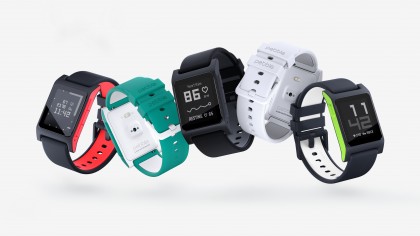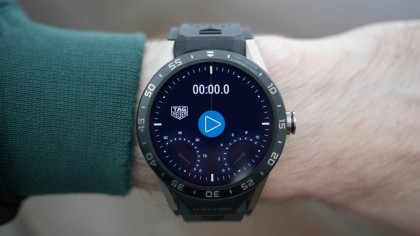Has the slow death march of the smartwatch begun?
Sales are down, interest is waning… smartwatches could be done

Pebble - the poster boy for smartwatches - has been sold to Fitbit for a nominal fee.
Smartwatch sales plummeted between June and September this year, with just 2.7 million units shipped worldwide - that’s 51% down on the same period last year, according to analysts IDC, continuing the recent downward sales trend for a sector that had seen solid growth since it really took off back in 2014.
Some see it as a portent of a death spiral. “I honestly don't think there's anything 'exciting' in [the smartwatch] market,” says Duncan Bell, Tech Lifestyle Editor for gadget magazine T3.
“They provide a second screen for people who don't want to play with their phones constantly but do want to be in touch at all times. I think, by definition, that’s a niche audience.
“I suspect most people who want a smartwatch have now bought one, and have discovered that, unlike a phone, annual or even two-yearly upgrades aren't really necessary.”
Worryingly, it seems the only optimism is coming from those actually making the products - and that’s precisely the stance you’d expect them to have.
“Right now, smartwatches just mimic what your phone does, and consumers can’t justify spending the equivalent amount to a phone on their watch,” says Jitesh Ubrani, senior market analyst at market research firm IDC.
Sign up for breaking news, reviews, opinion, top tech deals, and more.
We currently don’t know what impact the new Apple Watch 2 has had on the market (as Cook’s crew doesn’t release sales figures), and there’s talk of new Android Wear devices next year, but there’s nothing in the pipeline right now that strongly suggests the smartwatch category is about to experience a resurgence.
Not over yet
But for the smartwatch fan, brands working on connected wristwear do provide flickers of hope that it's not the beginning of the end, rather just a rocky start.
Manufacturers have told TechRadar that they see the smartwatch market as still very much in its infancy, and that tech innovations over the next two to three years will give consumers more motivation to spend on smartwatches.
One company seeking to address the problem is TAG Heuer, the legendary Swiss watchmaker, which earlier this year released a smartwatch – the TAG Heuer Connected – designed to appeal to watch ‘traditionalists’.

“Our watch looks like a watch, which is a huge difference,” TAG Heuer chief executive Jean-Claude Biver told TechRadar.
It’s niche – at more than £1,100 (US$1,500, around AU$2,100) it was always going to be – but it’s selling reasonably well for a product with that price tag.
TAG Heuer has put 60,000 Connected watches on wrists this year, with sales apparently only limited by production capacity, and Biver is forecasting sales of 150,000 next year.
The CEO believes innovation will drive the market forward. Smartwatches are in their ‘stone age’ at the moment, he says, like the early portable phones.
Our watch looks like a watch, which is a huge difference.
Jean-Claude Biver, TAG Heuer
It’s a common battle cry of anyone operating in a niche area of technology right now: pointing to the phone as once a slow burning sector before igniting; however, the iPhone was arguably the spark that began that fire, and the Apple Watch has shown that even the Cupertino brand can’t make the smartwatch a must-have thing.
However, Biver believes the market’s big bang will come when smartwatches become fully independent of phones, and able to make and receive calls on their own.
“As soon as you don’t need the phone next to you, many people will just go to a meeting without it, because they can answer [a call] with a Bluetooth headset,” he says.
Other manufacturers are also predictably optimistic about the fate of the smartwatch. Startup iMCO has created the CoWatch, which integrates with Amazon’s Alexa voice assistant and effectively functions like an Amazon Echo on your wrist, and was released earlier this year after a successful crowdfunding campaign.
When TechRadar asks iMCO co-founder Eric Jin if he’s nervous about declining sales in the market he bats away the question, taking a similar line to Biver and claiming that smartwatches are riding a similar curve to phones.
“Just look at smartphone growth,” he says. “At the beginning people were reluctant and prices were expensive. Now you have many more choices.
“I think you’ll have the same [trend with the] smartwatch, where we will provide more options at different price points. We’ll make the user experience friendlier and educate consumers so that it’s more acceptable to use it.”
Watches that target particular groups of consumers will be the most successful, Jin says. It’s a view backed up by the figures: Garmin, with its absolute focus on exercise, is the manufacturer having the most success in 2016, increasing its smartwatch market share in Q3 to 20%, up from 2% last year.
iMCO is designing a sport-focused watch for next year, as well as a CoWatch Lite, a slimmed down, more affordable version of its current model.
“[But] they’re more than just activity tracking,” Jin adds. “It gives you notifications, you can read messages through your watch, and [we believe] the trend is that people will use their smartwatch to make and receive phone calls.”
iMCO’s view of the smartwatch market sounds a little optimistic - all the things Jin lists are already part of the average smartwatch, and yet they haven’t helped to create a huge demand.
Phone block
TAG Heuer’s Biver thinks it’ll be the success of the ‘connected device’ ecosystem as a whole that will fire the future of the smartwatch. He envisions a phoneless future, where watches are just one part of a wearable ecosystem.
“When I talk with the CEO of Intel and my own engineers, they all say to me that in eight years the phone might be totally obsolete, because all the wearable products will communicate with each other with an incorporated SIM card,” he tells us.
In eight years the phone might be totally obsolete
Jean-Claude Biver, TAG Heuer
“If that’s true, then [the question] becomes obvious: why would you need a phone?”
It’s a radical view of the future, but not one that’s totally implausible. Professor Aaron Quigley, chair of Human Computer Interaction at the University of St Andrews School Of Computer Science, says smartwatches will be the perfect focal point of interaction with other wearables.
For one of his projects, called MultiFi, his team hooked up a smartwatch to a heads-up display, so that when the watch was held up, information displayed not only on the arm for the user, but around it.
“Your wrist becomes an extension of the display, or a peephole through which you can see more content or interact,” he says.
The system could be used with VR headsets or smartglasses, and Quigley believes using your hand, detected through your watch, is the most natural way to interact with these systems – much more natural than using a phone, for example.
“This is a technology that’s ready for deployment in the next generation of wearable devices, and there’s a lot to be said for the hands as a point of interaction,” he tells TechRadar.
The team is also working on other projects, like RadarCat, which allows users to interact with smartwatches without actually using a touchscreen.
“You can imagine [the touch panel] being out on the arm, so if you wanted to stop an alarm, you touch the back of your hand,” explains Quigley.
“When a slider appears and you want to control it, you move your fingers on your wrist or in the air above it.”
So there is innovation going on in the smartwatch space, and even the market analysts aren’t completely pessimistic.
Despite highlighting the declines in the market, IDC’s Ubrani agrees that when the connected watch sheds its dependence on the phone it will see a boost in sales, a view shared by technology goliath Qualcomm.
“We’re expecting an increase in cellular activity [in smartwatches], and by having that you’re making it independent of the phone, which is something that is needed, and you’re allowing developers to create new experiences,” he told us.
“We might see quarterly rises and falls, but the long-term trend will certainly be upward.”
The inflexion point
We’re at a pivotal moment for the smartwatch industry. Following huge declines in smartphone purchases earlier in 2016 all eyes were on the launch of market-leader Apple’s Watch 2 and, while we don’t have definitive sales numbers for the new device, IDC isn’t sounding positive.
We’re also expecting new smartwatches running Android Wear in 2017, but rumors of how they’ll look, and whether or not they’ll actually be worth buying, are rather thin on the ground.
But by mid-June next year we should have a good indication of where the smartwatch is going. And while some can foresee the end, there’s a chance – if the predictions of many actually making the watches are borne out – that this is just the beginning.